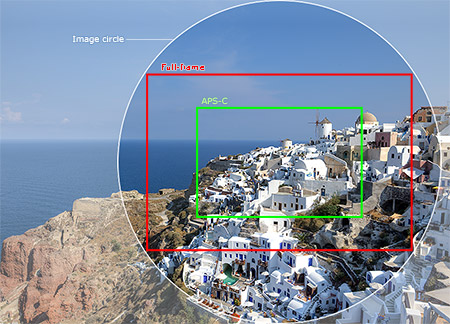 Nonsense
Nonsense
Take my word - I never ever intended to ridicule myself by exposing schoolmaster-like behavior on this website. But I just have to contribute my little share in straightening out an unfortunately widespread and even in serious photo magazines by now argumentatively well-established nonsense that I simply cannot take/hear/read any longer! Apparently it cannot be repeated often enough.
"Focal length extension" or "crop factor". Why 200 mm focal length never metamorphose to 320 mm.
The lens of a camera provides us with a circular image... the so-called image circle. The camera's viewfinder then shows us a rectangular cut-out of this image circle. This extract depends on the camera sensor's format.
The sensor format
A so-called "full-frame" camera with a sensor size of 36 mm x 24 mm (aspect ratio 3:2) produces a rectangular image circle cut-out whose size approximately corresponds to the diameter of the image circle.
However, most digital cameras on the market today are equipped with sensors that are smaller than full-frame sensors, for example sensors of the so-called APS-C size (sensor size approx 22.5 mm x 15 mm, aspect ratio also 3:2).
Click the image to enlarge it.
Referring to the resulting impact the use of a smaller sensor has on the picture, the term "focal length extension" is quite often and light-heartedly used (particularly in the German language where its termed Brennweitenverlängerung)... a completely misleading and cardinally wrong term, since a lens's focal length is by no means extended just because the lens is used on a camera with a sensor smaller than full-frame. A smaller sensor just covers a smaller area of the image circle; it simply creates a correspondingly smaller cut-out if the image circle. The rest around this cut-out is lost! The real representation size of the subject is always the same - regardless of the sensor!
The full-frame sensor of a Canon EOS 5D MkII, for example, has a side length of about 1.6 times longer than the APS-C sensor of a Canon EOS 7D or EOS 60D. This fact is then falsely called a "focal length extension by 1.6", just because a look through the viewfinder or at the LCD display creates the subjective impression of using a lens with a longer focal length.
This impression of a "focal length extension", however, simply results from the fact that the APS-C camera represents its smaller cut-out on the same, for example, 3 inch LCD display as a full-frame camera would represent its larger image on. The image reproduced on the APS-C camera's display is simply enlarged by the factor of 1.6.
Quite often this lack of understanding is getting to a point where someone using an APS-C camera multiplies himself a 50 mm lens to a "light telephoto" lens of 80 mm, or a 200 mm lens to a "super-tele" with a focal length of 320 mm. This is stark nonsense! An APS-C sensor does not zoom in on the subject 1.6 times; it is just lacking image information because that is cropped all-around.
Therefore, a far more accurate term than "focal length extension" would be "crop factor" — as the English language unmistakably terms it. In German: Beschnittfaktor.
So, what is to be done?
If I want to shoot with an APS-C sensor the exact same image as with a full-frame sensor, I inevitably have to reduce the image. There are two options to do so:
- I stay where I am. In that case I need a 1.6 times wider angle, ergo a 1.6 times shorter focal length (30 mm instead of 50 mm, for example). Now my image representation is identical to the one of a full-frame camera. The image, however, is physically smaller; the depth of field is greater. The perspective does not change because of the the shorter focal length; it depends solely on the the photographer's position!
- I do not change the lens but move away from the subject 1.6 times. Now I have the same image representation with the larger depth of field again, but also a different perspective because I changed my position.
Far too complicated?
Hmmm... perhaps a simple mnemonic aid? APSC = narrow-minded!
Got it now?

